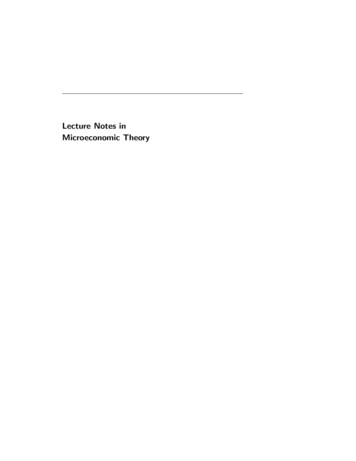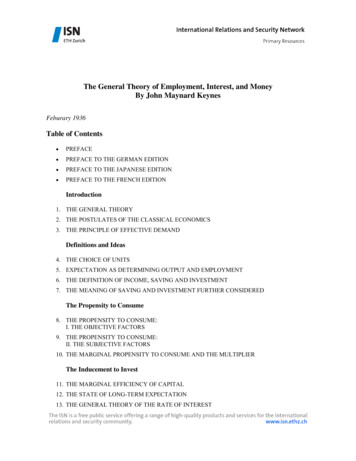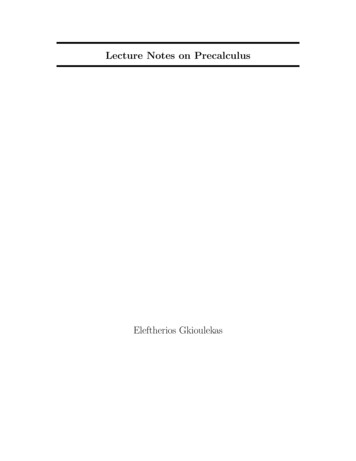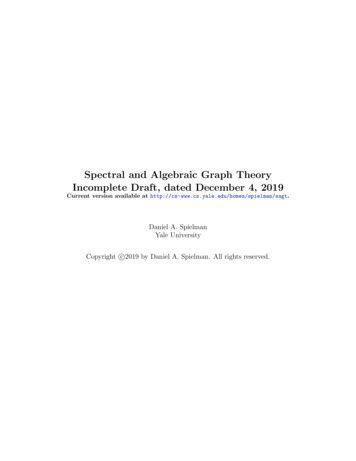
Transcription
Lecture Notes inMicroeconomic Theory
This is a revised version of the book, first published in 2005.This document was updated on November 1st, 2020.Please e-mail me with comments or corrections.A solution manual is available upon request by instructors only (seemy home-page).Ariel Rubinsteine-mail: rariel@tauex.tau.ac.ilhome-page: http://arielrubinstein.tau.ac.il
Lecture Notes inMicroeconomic TheoryThe Economic AgentSecond EditionAriel RubinsteinPRINCETON UNIVERSITY PRESSPRINCETON AND OXFORD
Copyright c 2012 by Princeton University PressPublished by Princeton University Press, 41 William Street, Princeton,New Jersey 08540In the United Kingdom: Princeton University Press, 60 Oxford Street,Woodstock, Oxfordshire OX20 1TWpress.princeton.eduAll Rights ReservedLibrary of Congress Cataloging-in-Publication DataRubinstein, Ariel.Lecture notes in microeconomic theory : the economic agent /Ariel Rubinstein. – 2nd ed.p. cm.Includes bibliographical references and index.ISBN 978-0-691-15413-8 (pbk. : alk. paper)1. Microeconomics. 2. Economics. I. Title.HB172.R72 2011338.5–dc232011026862British Library Cataloging-in-Publication Data is availableThis book has been composed in Times.Printed on acid-free paper. Typeset by S R Nova Pvt Ltd, Bangalore, IndiaPrinted in the United States of America10 9 8 7 6 5 4 3 2 1
ContentsPrefaceviiIntroductionixLecture 1. PreferencesProblem Set 1110Lecture 2. UtilityProblem Set 21221Lecture 3. ChoiceProblem Set 32444Lecture 4. Consumer PreferencesProblem Set 44861Lecture 5. Demand: Consumer ChoiceProblem Set 56376Lecture 6. More Economic Agents:a Consumer Choosing Budget Sets,b Dual Consumer and a ProducerProblem Set 67890Lecture 7. Expected UtilityProblem Set 794105Lecture 8. Risk AversionProblem Set 8108120Lecture 9. Social ChoiceProblem Set 912212860 Review Problems131References158
PrefaceThis is the 2018 revision of the second edition of my lecture notes for thefirst quarter of a microeconomics course for PhD (or MA) economics students. The lecture notes were developed over a period of 20 years duringwhich I taught the course at Tel Aviv University, Princeton University,and New York University.I published this book for the first time in 2007 and have revised itannually since then. I was hesitant about writing this book since severalsuperb books were already on the shelves. Foremost among them arethose of David Kreps. Kreps (1990) pioneered the shift of the gametheoretic revolution from research papers to textbooks. His book coversthe material in depth and includes many ideas for future research. Hismore recent book, Kreps (2013), is even better than his first and is nowmy clear favorite for a graduate microeconomics course.Three other books are on my shortlist: Mas-Colell, Whinston andGreen (1995) is a very comprehensive textbook; Bowles (2003) bringseconomics back to its authentic political economics roots; and Jehle andReny (1997) with its very precise style. They constitute an impressivecollection of textbooks for an advanced microeconomics course.My book covers only the first quarter of the standard course. It doesnot aim to compete with these other books. I published it and continueupdating it only because I think that it reflects a different point of viewon economic theory and some of the didactic ideas presented might bebeneficial to both students and teachers.Downloading Updated VersionsAs a matter of principle, the book is posted on the web and is availablefree of charge. I am grateful to Princeton University Press for allowingit to be downloaded for free immediately after publication.Since 2007, I have updated the book annually, adding material andcorrecting mistakes. My plan is to continue revising the book annuallyas long as I teach the course. To access the latest electronic version goto: http://arielrubinstein.tau.ac.il.
viiiPrefaceSolution ManualTeachers (and only teachers) of the course can also get an updated solution manual. I do my best to make the manual available only to teachersof a graduate course in microeconomics. Requests for the manual shouldbe made at: ughout the book I use only male pronouns. This is my deliberatechoice and does not reflect the policy of the editors or the publishers. Ibelieve that continuous reminders of the he/she issue simply divert readers’ attention. Language is of course important in shaping our thinking,but I feel it is more effective to raise the issue of discrimination againstwomen in the discussion of ”the issues” rather than raising flags on everypage of a book on economic theory.AcknowledgmentsI would like to thank all of my teaching assistants who made helpfulcomments during the many years I taught the course prior to the firstedition: Rani Spiegler, Kfir Eliaz, Yoram Hamo, Gabi Gayer, and TamirTshuva at Tel Aviv University; Bilge Yilmaz, Ronny Razin, WojciechOlszewski, Attila Ambrus, Andrea Wilson, Haluk Ergin, and DaisukeNakajima at Princeton; and Sophie Bade and Anna Ingster at NYU.Sharon Simmer and Rafi Aviav helped me with the English editing.Avner Shlain prepared the index.Special thanks to Benjamin Bachi for his devoted work in producingthe revised versions of the book for about a decade.
IntroductionAs a graduate student just starting out, you are at the beginning of anew stage in your life. In a few months you will be overloaded withdefinitions, concepts, and models. Your teachers will be guiding youinto the wonders of economics and will rarely stop to raise fundamentalquestions about what these models are supposed to mean. It is notunlikely that you will be brainwashed by the professionally soundinglanguage and hidden assumptions. I am afraid I am about to initiate youinto this inevitable process. Still, I want to pause for a moment and alertyou to the fact that many economists have strong and conflicting viewsabout what economic theory is. Some see it as a set of theories aboutthe interaction between individuals in economic situations, theories thatcan be tested. Others see it as a bag of tools to be used by economicagents. Many see it as a framework through which academic economistsview the world.My own view may disappoint those of you who have come to thiscourse with practical motives. In my view, economic theory is ”just” anarena for the investigation of concepts we use in thinking about real-lifeeconomic situations. What makes a theoretical model “economics” isthat the concepts we are analyzing are taken from real-life reasoningabout economic issues. Through the investigation of these concepts, wetry to better understand reality, and the models provide a language thatenables us to think about economic interactions in a systematic way. ButI do not view economic models as an attempt to describe the world, toprovide tools for predicting the future or to prescribe how people shouldbehave. I object to looking for an ultimate truth in economic theory, andI do not expect it to be the foundation for any policy recommendation.Nothing is “holy” in economic theory and everything in it is the creationof people like yourself.Essentially, this course consists of a discussion of concepts and modelsrelated to the behavior of a single economic agent. Although we willbe studying formal concepts and models, they will always be given aninterpretation. An economic model differs substantially from a purelymathematical model in that it is a combination of a mathematical modeland its interpretation. When mathematicians use terms such as “field”or “ring” that are in everyday use, it is only for the sake of convenience.
xIntroductionWhen they name a collection of sets a “filter”, they are doing so in anassociative manner; in principle, they could call it “ice cream cone”.When they use the term “well-ordering”, they are not making an ethicaljudgment. In contrast to mathematics, interpretation is an essentialingredient of an economic model and the names of the mathematicalobjects are an integral part of an economic model.The word “model” sounds more scientific than “fable” or “fairy tale”,but I don’t see much difference between them. The author of a fabledraws a parallel to a situation in real life and often has some moral hewishes to impart to the reader. A fable is an imaginary situation that issomewhere between fantasy and reality. Any fable can be dismissed asbeing unrealistic or simplistic, but this is also its advantage. As something between fantasy and reality, a fable is free of extraneous details andannoying diversions. In this unencumbered state, we can clearly discernwhat cannot always be discerned in the real world. On our return to reality, we are in possession of some relevant and useful argument. We doexactly the same thing in economic theory. A good model in economictheory, like a good fable, identifies a number of themes and elucidatesthem. We perform thought exercises that are only loosely connected toreality and have been stripped of most of their real-life characteristics.However, in a good model, as in a good fable, something significantremains.One can think about this book as an introduction of the charactersthat inhabit economic fables. Here, we feature the characters in isolation. In models of markets and games (not discussed in this textbook),we investigate the interactions between these characters.It is my hope that you will not be just a user of what is currently calledeconomic theory and that you will acquire alternative ways of thinkingabout economic and social interactions. At the very least, I would liketo encourage you to ask hard (and probably painful) questions abouteconomic models and whether they are relevant to real-life situationsand not simply take for granted that they are the ”right models”.MicroeconomicsIn this course we deal only with microeconomics, a collection of modelsin which the primitives are details about the behavior of units referredto as economic agents. An economic agent is the basic unit operating inthe model. Most often, we have in mind that the economic agent is anindividual, a person with one head, one heart, two eyes, and two ears.
IntroductionxiAlthough, in some economic models, the agent is a group of people,a family, or a government. At other times, the “individual” is brokendown into a collection of economic agents, each operating in differentcircumstances. However, the facade of generality in economic theory(and elsewhere) may be misleading. We have to be aware that whenwe take an economic agent to be a group of individuals, the reasonableassumptions about his behavior will differ from those in the case of asingle individual. For example, although it is quite natural to talk aboutthe will of a person, it is not clear what is meant by the will of a groupwhen the members of the group differ in their preferences.Bibliographic NotesFor an extensive discussion of my views about economic theory, seeRubinstein (2006a), and my semi-academic book Rubinstein (2012).
xiiIntroduction
Lecture Notes inMicroeconomic Theory
LECTURE 1PreferencesPreferencesOur economic agent will soon be advancing to the stage of economicmodels. Which of his characteristics will we be specifying in order toget him ready? One might suggest his name, age and gender, personalhistory, brain structure, needs, cognitive abilities, and emotional state.However, in most of economic theory, we only specify his attitude towardthe elements in some relevant set, and usually we assume that it can beexpressed in the form of preferences.We begin the course with a modeling “exercise” in which we seek todevelop a “proper” formalization of the concept of preferences. Althoughwe are on our way to constructing a model of rational choice, for nowwe will think about the concept of preferences independently of choice.This makes sense since we often use the concept of preferences in contextother than choice. For example, we can talk about an individual’s tastesover the paintings of the great masters even if he never makes a decisionbased on those preferences. We can talk about the preferences of anagent were he to arrive tomorrow on Mars or travel back in time andbecome King David, even if he does not believe in the supernatural.Actually, people often prefer elements that are forbidden for them tochoose.Imagine that you want to fully describe the preferences of an agent toward the elements in a given set X. For example, imagine that you wantto describe your own attitude toward the universities you have appliedto before finding out to which of them you have been admitted. Whatmust the description include? What conditions must the descriptionfulfill?We take the approach that a description of preferences should fullyspecify the attitude of the agent toward each pair of elements in X. Foreach pair of alternatives, it should provide an answer to the question ofhow the agent compares between the two alternatives. We present twoversions of this question. For each version, we formulate the consistency
2Lecture Onerequirements necessary for the responses to be “preferences’. We thenwill examine the connection between the two formalizations.The Questionnaire QThink about the preferences on a set X as answers to a long questionnaire Q that consists of all quiz questions of the type:Q(x,y) (for all distinct x and y in X):How do you compare x to y? Check one and only one of thefollowing three options: I prefer x to y (denoted by x y). I prefer y to x (denoted by y x). I am indifferent (denoted by I).A “legal” answer to the questionnaire is a response in which exactlyone of the boxes is checked in each question. We do not allowrefraining from answering a question or checking more than oneanswer. Furthermore, by allowing only the above three options weexclude plausible responses that demonstrate a lack of ability to makea comparison, such as: They are incomparable.I don’t know what x is.I have no opinion.I prefer both x over y and y over x.or that involve dependence on other factors, such as: It depends on what my parents think. It depends on the circumstances (sometimes I prefer x andsometimes I prefer y).or that involve the intensity of preferences, such as: I somewhat prefer x. I love x and I hate y.The constraints that we place on the legal responses of the agentsconstitute our implicit assumptions. Particularly important are the assumption that the elements in the set X are all comparable and the factthat we ignore the intensity of preferences.A legal answer to the questionnaire can be formulated as a functionf , which assigns to any pair (x, y) of distinct elements in X exactly one
Preferences3of the three “values”, x y or y x or I, with the interpretation thatf (x, y) is the answer to the question Q(x, y). (Alternatively, we can usethe notation of the soccer betting industry and say that f (x, y) mustbe 1, 2, or with the interpretation that f (x, y) 1 means that x ispreferred to y, f (x, y) 2 means that y is preferred to x, and f (x, y) means indifference.)Not all legal answers to the questionnaire Q qualify as preferencesover the set X . We will adopt two “consistency” requirements:First, the answer to Q(x, y) must be identical to the answer to Q(y, x).In other words, we want to exclude the “framing effect” by which peoplewho are asked to compare two alternatives tend to somewhat prefer thefirst one.Second, we require that the answers to Q(x, y) and Q(y, z) are consistent with the answer to Q(x, z) in the following sense. If the answersto the two questions Q(x, y) and Q(y, z) are “x is preferred to y” and“y is preferred to z”, then the answer to Q(x, z) must be “x is preferredto z”, and if the answers to the two questions Q(x, y) and Q(y, z) are“indifference”, then so is the answer to Q(x, z).To summarize, following is my favorite formalization of the notion ofpreferences:Definition 1Preferences on a set X are a function f that assigns to any pair (x, y)of distinct elements in X one of the three “values” x y, y x, or I sothat for any three different elements x, y, and z in X, the following twoproperties hold: No order effect : f (x, y) f (y, x). Transitivity :if f (x, y) x y and f (y, z) y z, then f (x, z) x z andif f (x, y) I and f (y, z) I, then f (x, z) I.Note again that here I, x y, and y x are merely symbols representing verbal answers. Needless to say, the choice of symbols is not anarbitrary one. (Is there any reason to use the notation I rather thanx y?)
4Lecture OneA Discussion of TransitivityTransitivity is an appealing property of preferences. How would youreact if somebody told you he prefers x to y, y to z, and z to x? Youwould probably feel that his answers are “confused”. Furthermore, itseems that, when confronted with intransitivity in their responses, people are embarrassed and want to change their answers.On some occasions before giving this lecture, I have asked studentsto fill out a questionnaire similar to Q regarding a set X that containsnine alternatives, each specifying the following four characteristics ofa travel package: location (Paris or Rome), price, quality of the food,and quality of the lodgings. The questionnaire included only thirtysix questions since for each pair of alternatives x and y, only one ofthe questions, Q(x, y) or Q(y, x), was randomly selected to appear inthe questionnaire (thus the dependence on the order of an individual’sresponse was not checked within the experimental framework). Out of1300 students who responded to the questionnaire, only 15% had nointransitivities in their answers, and the median number of triples inwhich intransitivity existed was 6. Many of the violations of transitivityinvolved two alternatives that were actually the same but differed inthe order in which the characteristics appeared in the description: “Aweekend in Paris at a 4-star hotel with food quality of Zagat 17 for 574”, and “A weekend in Paris for 574 with food quality of Zagat 17at a 4-star hotel”. All students expressed indifference between the twoalternatives, but in a comparison of these two alternatives to a thirdalternative—“A weekend in Rome at a 5-star hotel with food qualityof Zagat 18 for 612”— a quarter of the students gave responses thatviolated transitivity.Interestingly, I observed a negative correlation between the time ittook a student to respond to the questionnaire and whether he satisfiestransitivity of came close to it. The explanation is that most of thestudents who had no cycles of intransitivities formed their answers byapplying a simple and easy-to-execute rule (such as I prefer Paris toRome and I compare two vacation packages in the same city accordingto price). Students who compared the alternatives holistically withouta simple guiding rule were more likely to have cycles of intransitivity.In spite of the appeal of the transitivity requirement, note that whenwe assume that the attitude of an individual toward pairs of alternatives is transitive, we are excluding from the discussion individuals whobase their judgments on procedures that cause systematic violations oftransitivity. The following are two such examples:
Preferences51. Aggregation of considerations as a source of intransitivity. Sometimes, an individual’s attitude is derived from the aggregation ofmore basic considerations. Consider, for example, a case where X {a, b, c} and the individual has three primitive considerations in mind.The individual finds an alternative x to be better than an alternativey if a majority of considerations supports x. This aggregation processcan yield intransitivities. For example, if the three considerationsrank the alternatives as a 1 b 1 c, b 2 c 2 a, and c 3 a 3 b,then the individual determines a to be preferred over b, b over c, andc over a, thus violating transitivity.2. The use of similarities as an obstacle to transitivity. In some cases,an individual may express indifference in a comparison between twoelements that are too “close” to be distinguishable. For example,let X R (the set of real numbers). Consider an individual whoseattitude toward the alternatives is “the larger the better”; however, hefinds it impossible to determine whether a is greater than b unless thedifference is at least 1. He will assign f (x, y) x y if x y 1 andf (x, y) I if x y 1. This is not a preference relation because1.5 0.8 and 0.8 0.3, but it is not true that 1.5 0.3.Did we require too little? A potential criticism of the definition is thatour assumptions might be too weak and that we did not impose furtherreasonable restrictions on the concept of preferences. That is, there areother similar consistency requirements we might want to impose on alegal response in order for it to qualify it as a description of preferences.For example, if f (x, y) x y and f (y, z) I, we would naturally expect that f (x, z) x z. However, this additional consistency condition was not included in the above definition because it actually followsfrom the other conditions: if f (x, z) I, then by the assumption thatf (y, z) I and by the no-order effect, f (z, y) I, and thus by transitivity f (x, y) I (a contradiction) and if f (x, z) z x, then by theno-order effect f (z, x) z x, and by f (x, y) x y and transitivityf (z, y) z y (a contradiction).Similarly, note that for any preferences f , we have that if f (x, y) Iand f (y, z) y z, then f (x, z) x z.And by the way, this property of preferences is sometimes not attractive. The famous old pony-bicycle example demonstrates the point:Imagine a child who is indifferent between a pony and a bicycle. Thechild prefers a bicycle with a bell to a bicycle without one but is stillindifferent between a bicycle with a bell and a pony.
6Lecture OneThe Questionnaire RA second way to think about preferences is by means of an imaginaryquestionnaire R consisting of all questions of the type:R(x,y) (for all x, y X, not necessarily distinct): Is x at least aspreferred as y? Check one and only one of the following two boxes: Yes NoTo be a “legal” response, we require that the respondent checks exactlyone of the two boxes in each question. To qualify as preferences, a legalresponse must also satisfy two conditions:1. The answer to at least one of the questions R(x, y) and R(y, x) mustbe Yes. (In particular, the “silly” question R(x, x) that appears inthe questionnaire must get a Yes response.)2. For every x, y, z X, if the answers to the questions R(x, y) andR(y, z) are Yes, then so is the answer to the question R(x, z).We identify a response to this questionnaire with the binary relation% on the set X defined by x % y if the answer to the question R(x, y) isYes.(Reminder : An n-ary relation on X is a subset of X n . Examples:“Being a parent of” is a binary relation on the set of human beings;“being a hat” is an unary relation on the set of objects; “x y z” isa 3-ary relation on the set of numbers; “x is better than y more thanx0 is better than y 0 ” is 4-ary relation on a set of alternatives, etc. Ann-ary relation on X can be thought of as a response to a questionnaireregarding all n-tuples of elements of X where each question can get onlya Yes/No answer.)This brings us to the conventional definition of preferences:Definition 2Preferences on a set X is a binary relation % on X satisfying: Reflexivity : For any x X, x % x. Completeness: For any distinct x, y X, x % y, or y % x. Transitivity : For any x, y, z X, if x % y and y % z, then x % z.
Preferences7The Equivalence of the Two DefinitionsWe will now discuss the sense in which the two definitions of preferenceson the set X are equivalent. But first a reminder:The function f : X Y is a one-to-one function (or injection) iff (x) f (y) implies that x y.The function f : X Y is an onto function (or surjection) if for everyy Y there is an x X such that f (x) y.The function f : X Y is a one-to-one and onto function (or bijection, or one-to-one correspondence ) if for every y Y there is a uniquex X such that f (x) y.When we think about the equivalence of two definitions in economics,we are thinking about much more than the existence of a one-to-onecorrespondence: The correspondence also has to preserve the interpretation. Note the similarity to the notion of an isomorphism in mathematics where a correspondence has to preserve “structure”. For example,an isomorphism between two topological spaces X and Y is a one-toone function from X onto Y that is required to preserve the open sets.In economics, the analogue to “structure” is the less formal notion ofinterpretation.We will now construct a one-to-one and onto function, named Translation, between answers to Q that qualify as preferences by the firstdefinition and answers to R that qualify as preferences by the seconddefinition, such that the correspondence preserves the meaning of theresponses to the two questionnaires.To illustrate, imagine that you have two books. Each page in the firstbook is a response to the questionnaire Q that qualifies as preferencesby the first definition. Each page in the second book is a response to thequestionnaire R that qualifies as preferences by the second definition.The correspondence matches each page in the first book with a uniquepage in the second book, so that a reasonable person will recognize thatthe different responses to the two questionnaires reflect the same mentalattitudes toward the alternatives.Since we assume that the answers to all questions of the type R(x, x)are Yes, the classification of a response to R as preferences requiresonly the specification of the answers to questions R(x, y), where x 6 y.Table 1.1 presents the translation of responses.This translation preserves the interpretation we have given to theresponses. That is, if the response to the questionnaire Q exhibits that“I prefer x to y”, then the translation to a response to the questionnaireR contains the statement “I find x to be at least as good as y, but I
8Lecture OneTable 1.1A response to:Q(x, y) and Q(y, x)x yIy xA response to:R(x, y) and R(y, x)YesYesNoNoYesYesdon’t find y to be at least as good as x” and thus exhibits the samemeaning. Similarly, the translation of a response to Q that exhibits “Iam indifferent between x and y” is translated into a response to R thatcontains the statement “I find x to be at least as good as y, and I findy to be at least as good as x” and thus exhibits the same meaning.We will now prove that T ranslation is indeed a one-to-one correspondence between the set of preferences as given by definition 1, and theset of preferences as given by definition 2.Let f be a preference according to definition 1. First we check thatT ranslation(f ) is a legal response to R. By the no-order effect assumption, for any two alternatives x and y, one and only one of the followingthree answers could have been given by f for both Q(x, y) and Q(y, x):x y, I, and y x. Thus, the responses to R(x, y) and R(y, x) arewell-defined.Next we verify that T ranslation(f ) is indeed a preference relation (bythe second definition).Completeness: In each of the three rows, the answers to at least oneof the questions R(x, y) and R(y, x) is Yes.Transitivity: Assume that the answers given by T ranslation(f ) toR(x, y) and R(y, z) are Yes. This implies that the answer to Q(x, y) givenby f is either x y or I, and the answer to Q(y, z) is either y z orI. Transitivity of f implies that its answer to Q(x, z) is x z or I, andtherefore the answer to R(x, z) must be Yes.To see that T ranslation is indeed a one-to-one function, note that forany two different responses to the questionnaire Q there must be a question Q(x, y) for which the responses differ; therefore, the correspondingresponses to either R(x, y) or R(y, x) must differ.It remains to be shown that the range of T ranslation includes allpossible preferences as defined by the second definition. Let % (a response to R) be preferences by the second definition. We have to find afunction f , which is preferences by the first definition, that is converted
Preferences9by T ranslation into %. Reading from right to left, the table provides uswith a function f . The function is well-defined since by the completenessof %, for any two elements x and y, one of the entries in the right-handcolumn is applicable (the fourth option, in which the two answers toR(x, y) and R(y, x) are No, is excluded). By definition, f satisfies theno order effect condition.We still have to check that f satisfies the transitivity condition. Iff (x, y) x y and f (y, z) y z, then x % y and not y % x and y % zand not z % y. By transitivity of %, x % z. In addition, not z % x sinceif z % x, then the transitivity of % would imply z % y. If f (x, y) Iand f (y, z) I, then x % y, y % x, y % z, and z % y. By transitivity of%, both x % z and z % x, and thus f (x, z) I.SummaryI could have replaced the entire lecture with the following two sentences:“Preferences on X are a binary relation % on a set X satisfying reflexivity, completeness and transitivity. Denote x y when both x % y andnot y % x, and x y when x % y and y % x”. However, the role of thischapter was not just to introduce a formal definition of preferences butalso to conduct a modeling exercise and to make some methodologicalpoints:1. When we introduce two formalizations of the same verbal concept,we have to make sure that they indeed carry the same meaning.2. When we construct a formal concept, we make assumptions beyondthose explicitly mentioned. Being aware of the implicit assumptionsis important for understanding the concept and is useful in comingup with ideas for alternative formalizations.Bibliographic NotesFishburn (1970) contains a comprehensive treatment of preference relations.
Problem Set 1Problem 1. (Easy )Let % be a preference relation on a set X. Define I(x) to be the set of ally X f
first quarter of a microeconomics course for PhD (or MA) economics stu-dents. The lecture notes were developed over a period of 20 years during which I taught the course at Tel Aviv University, Princeton University, and New York University. I published this book for the fi










